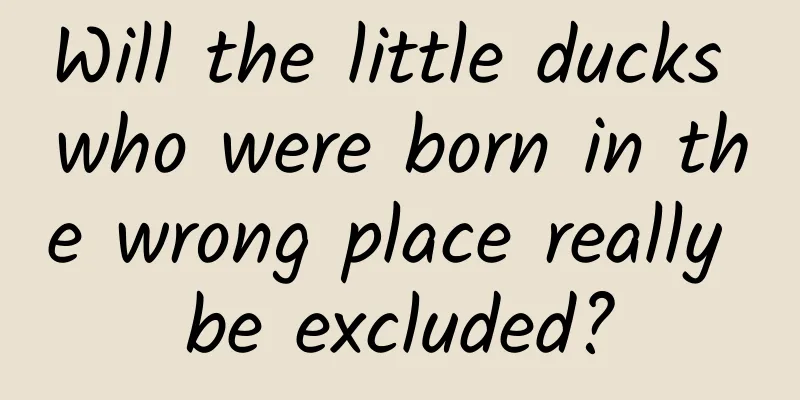Will the little ducks who were born in the wrong place really be excluded?

|
Produced by: Science Popularization China Author: Zhang Yingchao (Nature is within reach) Producer: China Science Expo Editor's note: In order to decode the latest mysteries of life science, the China Science Popularization Frontier Science Project has launched a series of articles called "New Knowledge of Life" to interpret life phenomena and reveal biological mysteries from a unique perspective. Let us delve into the world of life and explore infinite possibilities. I believe everyone has read the story of the ugly duckling in "Hans Christian Andersen's Fairy Tales", but have you ever thought about: why is the protagonist of the story who was born into someone else's nest not the "ugly chick" or the "ugly sparrow", but the ugly duckling? There is no doubt that the responsibility must first be attributed to the swan mother who laid this "duck egg". Here we first review a basic fact, that is, swans are taxonomically birds of the Anseriformes family, in other words, swans are also a kind of duck. Ducks occasionally lay their eggs in the nest of another female, so the appearance of the ugly duckling is not surprising. Will the little ducks who were born in the wrong place really be excluded? When the mother duck lays her eggs not only in another's nest but also in the nest of another species, the duck will be confused in its self-identity and aesthetics, and it will court ducks of the same species as its adoptive parents. What is even more surprising is that the ducks in nature do not seem to discriminate against this different brother like the half-sisters of the ugly duckling in the fairy tale. Instead, they accept this cross-species "love", which is a possible reason for the widespread hybridization of ducks. The plain fact is that more than 2,000 bird species hybridize, meaning they mate with at least one bird species other than their own, accounting for more than 20% of the total bird population (Ottenburghs et al. 2015). Left: Ancient painting "Hibiscus and Peacock" from the Song Dynasty Right: Golden Pheasant (b), Golden Pheasant (c), hybrid individual (d), (Image source: Peng et al) The picture above shows a hybrid individual recorded by Peng Minsheng from the Kunming Institute of Zoology, Chinese Academy of Sciences, in the ancient Song Dynasty painting "Hibiscus Pheasant". The bird in the painting has the characteristics of both the red-bellied pheasant (Chrysolophus pictus) and the white-bellied pheasant (Chrysolophus amherstiae), which means that the earliest record of bird hybridization can be traced back to about 900 years ago. Top view of an adult male golden-crowned darterfly (specimen from the Natural History Museum, Berlin) (Image source: Dysmorodrepanis) Unlike the short-lived hybrid bird in "Hibiscus and Golden Pheasant", in the remote Amazon rainforest, there is a hybrid bird called the Golden-crowned Flycatcher (Lepidothrix vilasboasi), or the Golden-crowned Manakin. Geographical isolation has allowed it to evolve into an independent species and survive to this day. It is also the first hybrid bird discovered by scientists in the Amazon rainforest. A pheasant hybrid born in Chongqing Zoo (Photo source: Du Hanyu, etc.) Compared with the natural state, mixed breeding in zoos actually leads to more bird hybridization, which is easier for us to observe. The above pheasant hybrid was born in Chongqing Zoo in 2019. From its morphological characteristics, it is preliminarily speculated that its parents may be ring-necked pheasants (Phasianus colchicus), blue peacocks or royal chickens (Gallus gallus domesticus). Finally, scientists identified its parents as ring-necked pheasants (Phasianus colchicus) and royal chickens (Gallus gallus domesticus) through genetic means. It is worth noting that as an important place for ex situ conservation, protecting species biodiversity is an important mission of zoos. In recent years, the "Hundred Birds Garden" and "Bird Singing Forest" created by zoos have increased the public's attention and understanding of birds, but have also brought challenges to the management of these birds, especially their reproduction. I once witnessed an interspecies bird hybridization. For a long time, the phenomenon of bird hybridization was just remembered by me as knowledge. The first time I observed hybridization of wild birds was in March 24, when I was taking a group of children to observe a striking common kingfisher in the Shanshui Garden of Hangzhou Botanical Garden. This was almost the peak of the appearance of common birds. As I was trying to describe to everyone that I had seen a subadult night heron hiding in the bushes, a mating male mallard and female spot-billed duck swam quickly past us, successfully attracting our attention. Mallard duck riding on the back of a spot-billed duck (Photo source: provided by the author) The mallard was on the back of the spot-billed duck, holding the duck's head and neck in its mouth. The duck quickly moved forward while flapping its wings up and down, and white waves appeared on the calm water, as if it was suddenly boiling. Then, the boiling bubbles quickly moved away from us. However, this is most likely not a moment of harmony in nature, but rather a moment of cruelty - forced mating in ducks is not an uncommon fact. Many observers have witnessed ducks' brutality, just as ducks are well known as one of the few birds with penises. Can cross-species love between birds succeed? This protracted "sexual arms race" has also given ducks peculiar genitals - a spiral male genitals shaped like a red wine corkscrew and a female reproductive tract with an opposite spiral structure. For this reason, although the incidence of forced sexual behavior is not low, few female ducks become pregnant as a result. Only when the female is willing will there be a relatively high probability of pregnancy. A study using mute ducks (Cairina moschata) as experimental subjects showed that the complex functions of the female vagina include expelling the male penis during forced sexual behavior (Brennan, Clark, and Prum 2010). At the same time, most interspecies romances are doomed to fail. They can never cross the gap of reproductive isolation and either fail to produce offspring or their offspring cannot live and reproduce normally. Even in the Anatidae family, where the incidence of forced sexual behavior is extremely high, more than 95% of ducklings come from mates actively chosen by the female duck. The popular woodpeckers are another type of individuals with widespread interspecies hybridization. For example, in urban areas where their distribution overlaps, at least 5.3% of the individuals are hybrid birds, but no hybrid birds have been observed to reproduce normally (Figarski 2018). The story of the ugly duckling's "counterattack" is not just an isolated case Back to the ugly duckling's nest. When a ball covered with grass and trees appeared among the yellow balls of fur that seemed to be woven by warm sunshine, the reason for discrimination did not seem so difficult to understand. Take the swan of the Cygnus genus as an example. The chicks are dull grayish white from the moment they hatch. It is not until the second year after molting that they turn into elegant snow-white. (Ma Ming et al., 1993) In nature, the story of the ugly duckling's "reversal" is by no means an isolated case. On the contrary, the phenomenon of birds changing color during development is widespread in nature. Take the moorhen, which is widely distributed in Eurasia and Africa. Its chicks are black, and they turn grayish white when they are young and sub-adults, and turn back to black when they are adults. It is only at this time that its bright red forehead becomes its most conspicuous feature. This characteristic of birds does cause some confusion for those who are new to bird watching, but it is also a source of fun and twists and turns - you may happily think you have observed a new species of bird, only to discover in the end that it is an old friend in a new look. These birds with "comeback" stories are also widely distributed and have large populations. They are also the birds that most people see frequently. In a way, they are actually more closely related to humans than those rare birds. While pursuing those rare birds, they are also worthy of our attention. References: 1. Du Hanyu, Kuang Gaoxiang, Ma Yue, et al. A case of inter-generic hybridization in Phasianidae and identification of parental species[J]. Journal of Wildlife Science, 2020, 41 (04): 1036-1046. DOI:10.19711/j.cnki.issn2310-1490.2020.04.027. 2. Liu Xia. Amazon hybrid birds become unique species due to geographical isolation[J]. Science Consulting (Science and Technology Management), 2018, (01): 4. 3. Ma Ming, Cai Dai, Gu Zhengqin, et al. Breeding ecology and beak shape variation of Whooper Swan_Ma Ming[J]. Arid Zone Research, 1993, (02): 46-51. 4. Brennan, Patricia LR, Christopher J. Clark, and Richard O. Prum. 2010. “Explosive Eversion and Functional Morphology of the Duck Penis Supports Sexual Conflict in Waterfowl Genitalia.” Proceedings of the Royal Society B: Biological Sciences 277(1686): 1309–14. doi:10.1098/rspb.2009.2139. 5. Figarski, Tomasz. 2018. “Hybrids and Mixed Pairs of Syrian and Great-Spotted Woodpeckers in Urban Populations.” J Ornithol. 6. Ottenburghs, J., Ydenberg, RC, Van Hooft, P., Van Wieren, SE & Prins, HHT 2015. The Avian Hybrids Project: gathering the scientific literature on avian hybridization. Ibis 157: 892–894. 7. Patricia LR Brennan, Christopher J. Clark and Richard O. Prum,2010. Explosive eversion and functional morphology of the duck penis supports sexual conflict in waterfowl genitalia. Proceedings of the Royal Society. B, Biological sciences , Vol.277 (1686), p.1309-1314 8. Peng, Min-Sheng, Fei Wu, Xiao-Jun Yang, and Ya-Ping Zhang. “An Ancient Record of an Avian Hybrid and the Potential Uses of Art in Ecology and Conservation.” |
>>: Every time a bunch of bananas is picked, a banana tree dies?
Recommend
Short video operation form, short video account "disassembly" methodology
Are you often troubled by the following problems ...
A comprehensive marketing plan for Mid-Autumn Festival and National Day!
September and October are the golden months, and ...
How much does it cost to be a beer agent? How much can a county-level beer agent earn in a year?
You can call Snow Flake's manufacturer in Han...
Astra: Fight again and again despite repeated failures, so what if the rocket flies
On August 29, 2021, Astra's "Rocket 3.3&...
Taking stock of the "history of the operational war between Tik Tok and Kuaishou"!
How do you evaluate the operation of Douyin ? Thi...
The gas tank explosion at a barbecue restaurant in Yinchuan has killed 31 people! If a gas tank catches fire or explodes, how can you save yourself?
On the evening of June 21, a gas explosion occurr...
Can instant noodles really have a 12-month shelf life? How can we prevent free radicals like viruses?
Recently, the media interviewed the following que...
Interpreting the universe! This "powerful" astronomical telescope sets a new world record!
Produced by: Science Popularization China Author:...
Carbon neutrality is cute, everyone should know it sooner
Hello everyone, I am the cute little carbon dioxi...
Want to lose weight but can’t control your diet? Let your brain help!
Obesity, as a complex chronic disease, leads to a...
How did these awesome Internet companies like Didi Dache, Momo, and Meituan promote themselves in the early stages?
How did Didi, Momo, and Meituan promote themselve...
"Happy family" or "Happy family", is it really true that you can't make the mistake in using them when greeting the new year?
Author: Cleaner, PhD student in Exegesis at Nanka...
7 copywriting templates for information flow ads, teach you how to hit the pain points!
With so much information flowing around, how can ...
【Pamela Reif】Pamela's full body fat burning exercise full set Baidu cloud download
【Pamela Reif】Pamela's full body fat burning e...
Product operation: new user activation rules!
The traffic dividend has slowly faded away. From ...


![[Li Jiaoshou] Why does it get worse the more we learn marketing from big brands?](/upload/images/67cc19637c62a.webp)






